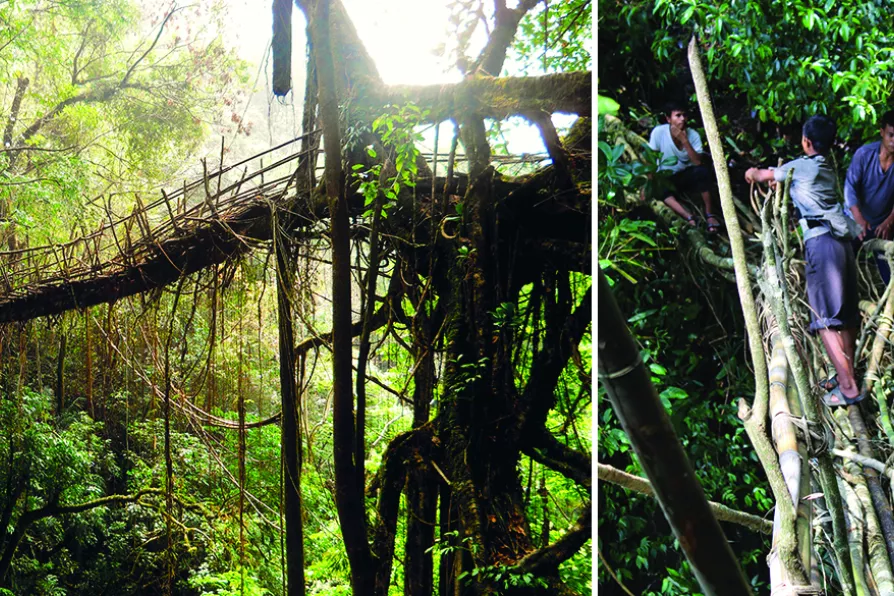As Labour continues to politically shoot itself in the foot, JULIAN VAUGHAN sees its electorate deserting it en masse

 IN HARMONY WITH NATURE: (L to R) The longest Rangthylliang living root bridge is over 50 metres; A root bridge being grown in Rangthylliang’s East Khasi Hills using a wood and bamboo scaffold
IN HARMONY WITH NATURE: (L to R) The longest Rangthylliang living root bridge is over 50 metres; A root bridge being grown in Rangthylliang’s East Khasi Hills using a wood and bamboo scaffold
MATERIALS can behave in strange and complicated ways we don’t understand. Nothing could make that clearer than the tragic and horrifying loss of life in the earthquakes last week that killed tens of thousands of people across southern Turkey and northern Syria.
The largest earthquake in Turkey since 1939 flattened cities across the region. The final death toll is predicted to be more than 50,000. Even the ground itself, and the hard bedrock that makes it up, has vast and complex networks of tension.
Earthquakes are incredibly difficult to predict, although doing this would allow for mass evacuations that could save thousands of lives.
Tremors erupt with very little notice. However, their distribution is not totally random. When analysed, the distribution of earthquakes is dictated by a statistical relationship called a power law.
Power laws are found all over in natural systems and share a few key features. One of these is “a long tail” – this means that although very large and dramatic events are rare, their probability does not dwindle away to nothing and they do sometimes occur.
Power laws occur when events are not truly unrelated to one another, but connected in complicated ways we don’t understand. Earthquakes fit the bill. Tremors occur after the build-up of stress in tectonic plates, itself linked to prior events.
The majority of people killed in the earthquakes were also killed by materials not behaving “as they should.”
People were crushed or trapped in falling debris from houses and buildings. The response of these materials, designed only to withstand the wear and tear of normal use, is easier to understand: they didn’t stand a chance.
Although concrete and iron aren’t complicated in the way that the Earth is, working out how an entire building can withstand a major rupture is difficult. Nevertheless, attempts have been made.
After the calamitous 1999 Izmit earthquake, new building codes were put in place to make future buildings earthquake-proof. But many new buildings fell too.
Much of the Turkish economy is supported by building projects and the Turkish government has been criticised for failure to implement the building codes, after multiple “amnesties,” in which non-compliant new buildings were allowed to remain standing to protect the profits of building companies. These buildings collapsed in the earthquakes, killing their occupants.
Even buildings nominally meeting the standards collapsed, crushing people in slabs of concrete. “Modern” building standards using modern materials are crude in the face of disasters. They contrast with the biological world, which has evolved over millions of years to make large solid structures in quite different ways. Learning from these ways could produce a paradigm shift in how we construct buildings.
In Meghalaya in north-east India, there is an ancient building technique for bridges over canyons and ladder trails up the side of steep slopes.
Communities build “living root bridges”, in which the above-ground (“aerial”) roots of living fig trees, Ficus elatica, are trained to grow along bamboo frames, and eventually to replace the frames and form the basis of large, stable and complex building projects. Trees, being profoundly complex organisms, have far more interesting mechanical properties than amorphous and simplistic concrete.
These building projects are entirely different to those built by construction companies for fast money and abandoned.
The building process is continuous: they must be constantly cared for and nurtured as they grow throughout their useful life. Although their craft is understood by the skilled bridge-weavers, the engineering principles that underpin the bridges are only slowly being understood by engineers and architects.
Nevertheless they are trying, and finding that a totally different approach to building gives the bridges their strength and resilience. The bridges are by no means disaster-proof, but the region in which they are grown is subject to earthquakes, landslides and floods.
The bridges are known not just to withstand many of these events (in 1897, the region was hit by an 8.2 Richter scale earthquake), but also believed to help protect the landscape and its inhabitants by providing additional stability over hundreds of years.
We are far away from replacing concrete and steel high rise buildings with houses and buildings made from living trees. The bridges are formed from complex interwoven strands, many of which seem unnecessarily complicated, in contrast to the lean minimal-quantity design of steel and concrete bridges.
However, the ability to imagine what our world could look like if principles from Meghalayan bridge-weavers, could be understood and implemented outside of their birthplace suggests a radical potential.
Cities could be made of buildings that don’t intrinsically condemn their citizens to death in the case of earthquakes.
The living root bridges themselves are at risk from the same building materials that kill in earthquakes: cement. Although their rich architecture provokes fascination worldwide, the region is desperately poor.
Several huge European and US TV companies have recently made sumptuous documentaries about the region and the bridges (they were featured prominently in the final episode of Human Planet), although the film producers have paid a pittance to use the locations and interview the communities.
Over the last decade, the second largest cement company in the world Lafarge, via its subsidiary, Lafarge Umiam Mining Pvt. Ltd (LUMPL), have bought up a vast swathe of the rainforest around the area with the highest density of living bridges.
A local official arranged for payments of about £500 to landowners in the region, with a promise of five years before the mining started. A road building project in the region recently caused a massive landslide. Another landslide was produced by an open limestone mine in nearby Rngain.
Concrete is encroaching above ground too. An Indian job scheme (MNREGA projects) which pays 120 days’ work to the unemployed is often used to create steps around the nearby settlements. Concrete for this is sold by the cement company directly.
The concrete steps are totally unsuited to the landscape, unsustainable and destabilising to the very old and stable existing paths, known locally as “ancient trails.”
A local activist group called the Living Bridge Foundation, led by Morningstar Khongthaw, organises people to protect the skills, knowledge and communities that maintain the bridges.
They promote living bridge tourism as a way to bring money into the region and fend off the advances of Lafarge. Thanks to this tourism, the people living around the living bridges themselves were able to refuse the money from Lafarge.
The work of this tiny group of heroic activists is thereby currently protecting what they can of a community, a culture, and a swathe of healthy rainforest from the European company that in 2021 sold £23 billion worth of cement.
From the hidden complexity that produces earthquakes, to the secrets of trees that can withstand them, the world is deeply interconnected and woven through with structure that we have barely scratched the surface of. We can’t afford to concrete over the rich complexity of ecological and human life.

The distinction between domestic and military drones is more theoretical than practical, write ROX MIDDLETON, LIAM SHAW and MIRIAM GAUNTLETT

Nature's self-reconstruction is both intriguing and beneficial and as such merits human protection, write ROX MIDDLETON, LIAM SHAW and MIRIAM GAUNTLETT

A maverick’s self-inflicted snake bites could unlock breakthrough treatments – but they also reveal deeper tensions between noble scientific curiosity and cold corporate callousness, write ROX MIDDLETON, LIAM SHAW and MIRIAM GAUNTLETT
Science has always been mixed up with money and power, but as a decorative facade for megayachts, it risks leaving reality behind altogether, write ROX MIDDLETON, LIAM SHAW and MIRIAM GAUNTLETT














